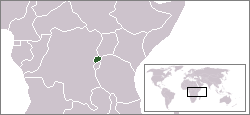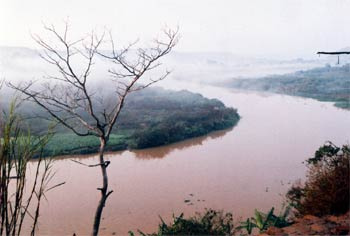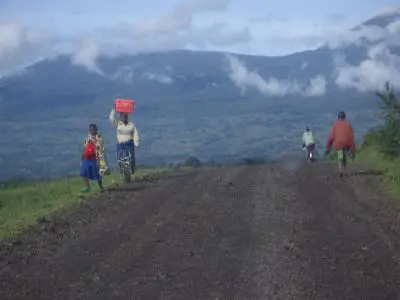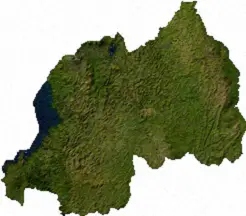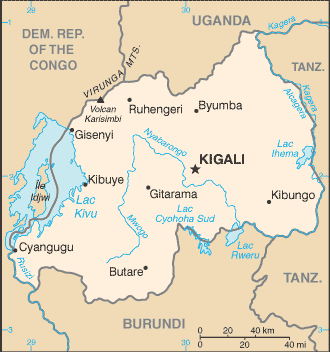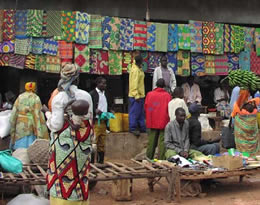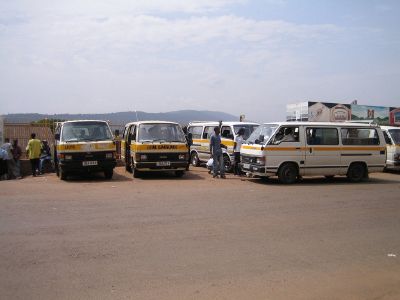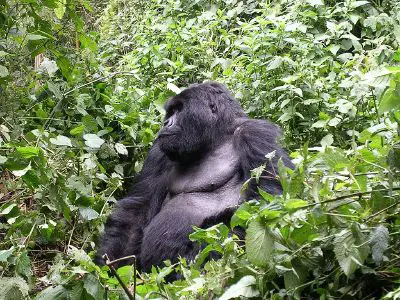Rwanda
| Repubulika y'u Rwanda République du Rwanda Republic of Rwanda |
||||||
|---|---|---|---|---|---|---|
|
||||||
| Motto: Ubumwe, Umurimo, Gukunda Igihugu "Unity, Work, Patriotism" |
||||||
| Anthem: "Rwanda nziza" "Beautiful Rwanda" |
||||||
| Capital (and largest city) | Kigali 1¬į56.633‚Ä≤S 30¬į3.567‚Ä≤E | |||||
| Official languages | Kinyarwanda, French, English | |||||
| Demonym | Rwandan, Rwandese | |||||
| Government | Unitary parliamentary democracy and Presidential republic | |||||
|  -  | President | Paul Kagame | ||||
| ¬†-¬† | Prime Minister | √Čdouard Ngirente | ||||
| Independence | ||||||
|  -  | from Belgium | July 1, 1962  | ||||
| Area | ||||||
|  -  | Total | 26,338 km² (148th) 10,169 sq mi  |
||||
|  -  | Water (%) | 5.3 | ||||
| Population | ||||||
|  -  | 2023 estimate | 13,400,541[1] (76th) | ||||
|  -  | Density | 470/km² (22nd) 1,217/sq mi |
||||
| GDP (PPP) | 2022 estimate | |||||
|  -  | Total | |||||
|  -  | Per capita | |||||
| GDP (nominal) | 2023 estimate | |||||
|  -  | Total | |||||
|  -  | Per capita | |||||
| Gini (2016) | 43.7[3]  | |||||
| Currency | Rwandan franc (RWF) |
|||||
| Time zone | CAT (UTC+2) | |||||
|  -  | Summer (DST) | not observed (UTC+2) | ||||
| Internet TLD | .rw | |||||
| Calling code | +250 | |||||
Rwanda, officially the Republic of Rwanda, is a small landlocked country in the Great Lakes region of east-central Africa, with great natural beauty but few exportable resources. Its hilly terrain, which gives it the title Pays des Mille Collines ("Land of a Thousand Hills"), supports the densest population in sub-Saharan Africa.
The country is infamous for the 1994 genocide that resulted in the deaths of up to one million people. Since then, the government has been making efforts to bring the people together, but Rwanda still faces numerous problems. This nation, however, is at the forefront of a new concept of ensuring peace through the implementation of a law requiring a high percentage of women within the Parliament. This is based upon the idea that women will never allow the incidence of mass killing to be reproduced.
Geography
Rwanda is located near the center of Africa, a few degrees south of the equator. It is separated from the Democratic Republic of Congo by Lake Kivu and the Ruzizi River valley to the west; it is bounded on the north by Uganda, to the east by Tanzania, and to the south by Burundi. The capital, Kigali, is located in the center of the country.
Rwanda's countryside is covered by grasslands and small farms extending over rolling hills, with areas of rugged mountains that extend southeast from a chain of volcanoes in the northwest. The divide between the Congo and Nile drainage systems extends from north to south through western Rwanda at an average elevation of almost 9,000 feet (2,740 m). On the western slopes of this ridgeline, the land slopes abruptly toward Lake Kivu and the Ruzizi River valley and constitutes part of the Great Rift Valley. The eastern slopes are more moderate, with rolling hills extending across central uplands at gradually reducing altitudes, to the plains, swamps, and lakes of the eastern border region. Therefore the country is also known as the "Land of a Thousand Hills."[4]
In 2006, a British-led exploration announced that they had located the longest headstream of the Nile River in Nyungwe Forest in Rwanda.[5]
Climate
Though Rwanda is a tropical country, only two degrees south of the equator, its high elevation makes the climate temperate. In the mountains, frost and snow are possible. The average daily temperature near Lake Kivu, at an altitude of 4,800 feet (1,463¬†m) is 73¬įF (23¬įC). Rwanda is considered the lightning capital of the world, due to intense daily thunderstorms during the two rainy seasons (February‚ÄďApril and November‚ÄďJanuary).
Annual rainfall averages 31 inches (830 mm) but is generally heavier in the western and northwestern mountains than in the eastern savannas.
History
Although the Twa (pygmies) were the original people living in the area now known as Rwanda, possibly as far back as 30,000 B.C.E., by the fifteenth century the Hutu and Tutsi had moved in. The Hutus primarily were farmers who lived on hilltops, and the Tutsi were warriors and herders who lived on the hillsides and in the valleys. In the nineteenth century that evolved into a feudal-type system with sharp social divisions in which Tutsis dominated.
Because of its mountainous terrain, Rwanda was spared the onslaughts of invaders and slave traders. John Hanning Speke was the first European to visit Rwanda. In 1895 the Rwandan king accepted German rule to maintain his power, and the area became part of German East Africa. The Germans did nothing to develop the country economically. They kept the indigenous administration system by applying the same type of indirect rule established by the British Empire in the Ugandan kingdoms.
Twentieth century
After Germany's loss in World War I, Belgium took over Rwanda with a League of Nations mandate. Belgian rule in the region was far more direct and harsh than German rule. The Belgian colonizers did realize the value of native rule, however. Backed by Christian churches, the Belgians favored the minority Tutsi upper class over lower classes of Tutsis and Hutus. Belgian forced labor policies and stringent taxes were mainly enforced by the Tutsi upper class, which the Belgians used as buffers against the people's anger, thus further polarizing the Hutu and the Tutsi. Many young peasants, to escape tax harassment and hunger, migrated to neighboring countries. They moved mainly to Congo but also to Ugandan plantations, looking for work.
After World War II, Rwanda became a United Nations (UN) trust territory administered by Belgium. In 1959, King Mutara III Charles was assassinated and his younger brother became the Abega clan monarch, King Kigeli V. In 1961, King Kigeli V was in Kinshasa to meet with U.N. Secretary-General Dag Hammarskjöld when Dominique Mbonyumutwa, with the support of the Belgian government, led a coup d'état. The coup overthrew King Kigeli V and the Hutu gained more and more power. Upon Rwanda's independence on July 1, 1962, the Hutu held virtually all power.
Gregoire Kayibanda was the first president (1962‚Äď1973), followed by Juvenal Habyarimana (1973‚Äď1994). The latter, who many view as a ruthless dictator, was unable to find a solution to increasing social unrest, calls for democracy, and the long-running problem of Rwandan Tutsi refugees. By the 1990s, Rwanda had up to one million refugees scattered around neighboring countries, mostly in Uganda and Burundi.
In 1990, the Tutsi-dominated Rwandan Patriotic Front (RPF) invaded Rwanda from Uganda. During the fighting, top Rwandan government officials, mainly Hutu, began secretly training young men into informal armed bands called Interahamwe (a Kinyarwanda term roughly meaning "those who fight together"). Government officials also launched a radio station that began anti-Tutsi propaganda. The military government of Habyarimana responded to the RPF invasion with pogroms against Tutsis, whom it claimed were trying to re-enslave the Hutus. In August 1993, the government and the RPF signed a cease-fire agreement known as the Arusha Accords in Arusha, Tanzania, to form a power-sharing government, but fighting between the two sides continued. The United Nations sent a peacekeeping force known as the United Nations Assistance Mission for Rwanda (UNAMIR). UNAMIR was vastly underfunded and understaffed.
During the armed conflict, the RPF was blamed for the bombing of the capital Kigali. These attacks were actually carried out by the Hutu army as part of a campaign to create a reason for a political crackdown and ethnic violence. On April 6, 1994, President Habyarimana was assassinated when his airplane was shot down while landing in Kigali. [6] It remains unclear who was responsible for the assassination‚ÄĒmost credible sources point to the Presidential Guard, spurred by Hutu nationalists fearful of losing power, but others believe that Tutsi rebels were responsible, possibly with the help of Belgian mercenaries.
Over the next three months, with logistical and military assistance and training from France, the military and Interahamwe militia groups killed between half a million and one million Tutsis and Hutu moderates in the Rwandan genocide. The RPF continued to advance on the capital, and occupied the northern, eastern, and southern parts of the country by June. Thousands of civilians were killed in the conflict. U.N. member states refused to answer UNAMIR's requests for increased troops and money. Meanwhile, French troops were dispatched to stabilize the situation, but this only exacerbated the situation, with the evacuation limited to foreign nationals.
On July 4, 1994, the war ended as the RPF entered Kigali. Over two million Hutus fled the country, fearing Tutsi retribution. Most have since returned, but some remain in the Congo, including some militia members who later took part in the First and Second Congo Wars. After repeated unsuccessful appeals to the United Nations and the international community to deal with the security threat posed by the remnants of the defeated genocidal forces on its eastern border, in 1996, Rwanda invaded eastern Zaire in an effort to eliminate the Interahamwe groups operating there. This action, and a simultaneous one by Ugandan troops, contributed to the outbreak of the First Congo War and the eventual fall of longtime dictator Mobutu Sese Seko.
Rwanda today struggles to heal and rebuild, and shows signs of rapid development, but some Rwandans continue to struggle with the legacy of genocide and war. In 2004, a ceremony was held in Kigali at the Gisozi Memorial (sponsored by the Aegis Trust and attended by many foreign dignitaries) to commemorate the tenth anniversary of the genocide. The country observes a national day of mourning each year on April 7. Rwandan genocidal leaders were put on trial at the International Criminal Tribunal, in the Rwandan National Court system and through the informal Gacaca village justice program.
The current Rwandan government has been praised by many for establishing security and promoting reconciliation and economic development, but is also criticized by some for being too militant and opposing dissent.
Government
After its military victory in July 1994, the Rwandan Patriotic Front organized a coalition government based on the 1993 Arusha accords and political declarations by the parties. The National Movement for Democracy and Development‚ÄĒHabyarimana's party that instigated and implemented the genocidal ideology‚ÄĒalong with the CDR (another Hutu extremist party) were banned, with most of its leaders either arrested or in exile.
After the 1994 genocide, the Hutu people living in refugee camps were attacked by Tutsi forces.
A new constitution was adopted by referendum and promulgated in 2003. The first postwar presidential and legislative elections were held in August and September 2003, respectively. The RPF-led government has continued to promote reconciliation and unity among all Rwandans as enshrined in the new constitution that forbids any political activity or discrimination based on race, ethnicity, or religion.
By law, at least a third of the Parliament representation must be female. It is believed that women will not allow the mass killings of the past to be repeated. Rwanda topped a recently conducted global survey on the percentage of women in Parliament with as much as 49 percent female representation.[7]
Administrative divisions
Prior to January 1, 2006, Rwanda was composed of twelve provinces, but these were abolished in full and redrawn as part of a program of decentralization and reorganization.
Rwanda is divided into five provinces and subdivided into thirty districts. The provinces are:
- North Province
- East Province
- South Province
- West Province
- Kigali Province
Military
Rwanda's armed forces consist of mostly infantry and an air force. In 2002, there were a reported 15,000‚Äď20,000 troops stationed in the Congo. The paramilitary consists of national police and local defense forces.
Opposition forces may number around 15,000 in the Army for the Liberation of Rwanda, which consists of Hutu rebels. The civil war of 1994 weakened the government armed forces, which could not stop the Hutu‚ÄďTutsi tribal conflict.[8]
Foreign relations
Rwanda was granted United Nations membership on September 18, 1962. It is a member of the African Development Bank, G-77, and the African Union. It is also a signatory of the Law of the Sea and a member of the World Trade Organization.
In 1976, Rwanda joined Burundi and Zaire (now known as the Democratic Republic of Congo) in the Economic Community of the Great Lakes Countries, formed to develop the economic potential of the basin of lakes Kivu and Tanganyika. In 1977, Rwanda joined Burundi and Tanzania in forming an economic community for the management and development of the Kagera River basin. Uganda became a part of the community in 1980. Its headquarters are in Kigali. [9]
Economy
Rwanda is a rural country with about 90 percent of the population engaged in subsistence agriculture. It is landlocked with few natural resources and minimal industry.
Primary exports are coffee and tea, with the addition in recent years of minerals (mainly Coltan, used in the manufacture of electronic and communication devices such as mobile phones) and flowers. Tourism is also a growing sector, notably around ecotourism (Nyungwe Forest, Lake Kivu) and the world-famous and unique mountain gorillas in the Virunga park. It has a low gross national product (GNP), and it has been identified as a Heavily Indebted Poor Country (HIPC). In 2005, its economic performance and governance achievements prompted international funding institutions to cancel nearly all its debts.
According to the World Food Programme, it is estimated that 60 percent of the population lives below the poverty line and 10‚Äď12 percent of the population suffers from food insecurity every year.
In 2006, China proposed funding a study for building a railway link from Bujumbura in Burundi to Kigali in Rwanda to Isaki in Tanzania. China has also offered economic cooperation in agriculture, energy, education, and industry.
Demographics
Most Rwandans speak Kinyarwanda. It is difficult to establish exactly what words like "Tutsi" and "Hutu" meant before the arrival of European colonists, because there was no written history. In the twenty-first century a number of Rwandans rejected the idea of sub-races and simply identify themselves as "Rwandans."
Rwanda's population density, even after the 1994 genocide, is among the highest in sub-Saharan Africa at 590 people per square mile (230/km²). The country has few villages, and nearly every family lives in a self-contained compound on a hillside. The urban concentrations are grouped around administrative centers.
The indigenous population consists of three ethnic groups. The Hutus, who comprise the majority of the population (85 percent), are farmers of Bantu origin. The Tutsis (14 percent before the genocide, less than 10 percent now) are a pastoral people who arrived in the area in the fifteenth century. Until 1959, they formed the dominant caste under a feudal system based on cattleholding. The "Twa" or pygmies, (1 percent) are thought to be the remnants of the earliest settlers of the region.
The majority of Rwandans are Christian. Due to the widespread involvement of both Roman Catholic and Protestant clergy in the Rwandan genocide and the shelter and protection given to members of both ethnic groups of all religions by Muslims, widespread conversion occurred, causing the Muslim population increase substantially.[10]
During 1994‚Äď1995, most primary schools and more than half of pre-war secondary schools reopened. The national university in Butare reopened in April 1995. Rebuilding the educational system has been a high priority of the Rwandan government.
Society and culture
The family unit, or inzu, is the most important unit in Rwandan culture. Usually its members live together on a rural homestead. Marriage has a high value, with many arranged by families. The groom's family must pay a dowry to the bride's family.
A rich oral tradition has been passed on through epic poetry, storytelling, and public speaking. Nearly every celebration has music and dancing.
Women weave mats and baskets, while men make drums, pipes, bowls, and other useful items out of wood.
Soccer is the most popular sport.
Rwanda in Films
- Gorillas in the Mist (1988): Feature film dramatizing the work of American ethnologist Dian Fossey, who studied gorillas in Rwanda's mountain forests until her murder there in 1985.
- Hotel Rwanda (2004): Feature film dramatizing the true story of Paul Rusesabagina, a hotel manager who housed over a thousand threatened Tutsi refugees during the 1994 genocide.
- 100 Days of Slaughter (2004).
- Shake Hands With the Devil: The Journey of Roméo Dallaire (2004): Documentary chronicling Canadian Lieutenant-General Roméo Dallaire's perspective on the 1994 genocide in Rwanda ten years later. Dallaire returns to Rwanda to reflect on the changes since his last stay there.
- Shooting Dogs (2005): Dramatic feature film based on the true story of a Catholic priest and a young idealistic English teacher caught in the 1994 Rwandan genocide.
- Sometimes In April (2005): Dramatic feature film focusing on the experiences of an intermarried Hutu‚ÄďTutsi family during the 1994 genocide.
- Un dimanche à Kigali (2006).
- Shake Hands with the Devil (2006): Dramatic feature film adaptation of the autobiographical book by Lieutenant-General Roméo Dallaire.
- Back Home (2006): Documentary directed by J. B. Rutagarama, a survivor of the 1994 genocide in Rwanda. A personal journey toward understanding what led to the genocide and forgiving those who murdered his family.
Notes
- ‚ÜĎ CIA, Rwanda The World Factbook. Retrieved September 28, 2023.
- ‚ÜĎ 2.0 2.1 2.2 2.3 World Economic Outlook Database, April 2023 International Monetary Fund. Retrieved September 28, 2023.
- ‚ÜĎ Gini index - Rwanda The World Bank. Retrieved September 28, 2023.
- ‚ÜĎ Vivienne Dovi, Rwanda is the land of 1,000 hills: Here's why it should be on your bucket list EuroNews (November 7, 2022). Retrieved September 28, 2023.
- ‚ÜĎ BBC News, Team reaches Nile's 'true source', March 31, 2006. Retrieved September 28, 2023.
- ‚ÜĎ Rwanda Genocide - April-July 1994 Global Security. Retrieved September 28, 2023.
- ‚ÜĎ Tsjeard Bouta and Georg Frerks, Gender, Conflict, and Development (Washington, DC: World Bank, 2005), 56.
- ‚ÜĎ Rwanda Armed Forces Encyclopedia of the Nations. Retrieved September 28, 2023.
- ‚ÜĎ Rwanda International Cooperation Encyclopedia of the Nations. Retrieved September 28, 2023.
- ‚ÜĎ Emily Wax, Islam Attracting Many Survivors of Rwanda Genocide The Washington Post (September 23, 2002). Retrieved September 28, 2023.
ReferencesISBN links support NWE through referral fees
- Bouta, Tsjeard, and Georg Frerks. Gender, Conflict, and Development. Washington, DC: World Bank, 2004. ISBN 978-0821359686
- Carr, Rosamond Halsey, and Ann Howard Halsey. Land of a Thousand Hills: My Life in Rwanda. New York: Viking, 1999. ISBN 0670887803
- Curtin, Philip, et al. African History: From Earliest Times to Independence, 2nd ed. New York: Addison Wesley Longman, 1995. ISBN 0582050707
- Cutter, Charles H. Africa: 2006, 41st ed. Harpers Ferry, WV: Stryker-Post Publications, 2006. ISBN 1887985727
- Fisanick, Christina (ed.). The Rwanda Genocide. Farmington Hills, MI: Greenhaven Press, 2004. ISBN 0737719869
- Guillebaud, Meg. Rwanda: The Land God Forgot? Revival, Genocide and Hope. Kregel Publications, 2002. ISBN 978-1854245762
- Ilibagiza, Immaculée, and Steve Erwin. Left to Tell: Discovering God amidst the Rwandan Holocaust. Carlsbad, CA: Hay House, 2006. ISBN 1401908969
- Iliffe, John. Africans: The History of a Continent. New York: Cambridge University Press, 1996. ISBN 0521484227
- Mushikiwabo, Louise, and Jack Kramer, Rwanda Means the Universe: A Native's Memoir of Blood and Bloodlines. New York: St. Martin's Press, 2006. ISBN 978-0312209599
External links
All links retrieved September 27, 2023.
- Rwanda The World Factbook
- Rwanda AllAfrica
- Rwanda country profile BBC
- U.S. Relations With Rwanda US State Department
- Rwanda Global Issues
- Voices of Rwanda Rwanda Testimony Film Project
- Survivors Fund Supporting survivors of the Rwandan genocide
Burundi¬†‚ÄĘ Central African Republic¬†‚ÄĘ Chad¬†‚ÄĘ Democratic Republic of the Congo¬†‚ÄĘ Rwanda
Sovereign states
Algeria ·
Angola ·
Benin ·
Botswana ·
Burkina Faso ·
Burundi ·
Cameroon ·
Cape Verde ·
Central African Republic ·
Chad ·
Democratic Republic of the Congo ·
Republic of the Congo ·
Comoros ·
C√īte d'Ivoire ¬∑
Djibouti ·
Egypt1 ·
Equatorial Guinea ·
Eritrea ·
Ethiopia ·
Gabon ·
The Gambia ·
Ghana ·
Guinea-Bissau ·
Guinea ·
Kenya ·
Lesotho ·
Liberia ·
Libya ·
Madagascar ·
Malawi ·
Mali ·
Mauritania ·
Mauritius ·
Morocco ·
Mozambique ·
Namibia ·
Niger ·
Nigeria ·
Rwanda ·
Senegal ·
Seychelles ·
Sierra Leone ·
Somalia ·
South Africa ·
Spain2 ·
Sudan ·
Swaziland ·
São Tomé and Príncipe ·
Tanzania ·
Togo ·
Tunisia ·
Uganda ·
Zambia ·
Zimbabwe
Dependencies  |  Unrecognized
British Indian Ocean Territory (UK) ·
French Southern and Antarctic Lands (France) ·
Mayotte (France) ·
Réunion (France) ·
St. Helena3 (UK)
 | 
Puntland ·
Somaliland ·
Sahrawi Arab Democratic Republic
1 Partly in Asia.  2 Mostly in Europe.  3 Includes the dependencies of Ascension Island and Tristan da Cunha.
Algeria ¬∑ Angola ¬∑ Benin ¬∑ Botswana ¬∑ Burkina¬†Faso ¬∑ Burundi ¬∑ Cameroon ¬∑ Cape¬†Verde ¬∑ Central¬†African¬†Republic ¬∑ Chad ¬∑ Comoros ¬∑ Democratic¬†Republic of the¬†Congo ¬∑ Republic¬†of the¬†Congo ¬∑ C√īte¬†d'Ivoire ¬∑ Djibouti ¬∑ Egypt ¬∑ Eritrea ¬∑ Ethiopia ¬∑ Equatorial¬†Guinea ¬∑ Gabon ¬∑ The¬†Gambia ¬∑ Ghana ¬∑ Guinea ¬∑ Guinea-Bissau ¬∑ Kenya ¬∑ Lesotho ¬∑ Liberia ¬∑ Libya ¬∑ Madagascar ¬∑ Malawi ¬∑ Mali ¬∑ Mauritania ¬∑ Mauritius ¬∑ Mozambique ¬∑ Namibia ¬∑ Niger ¬∑ Nigeria ¬∑ Rwanda ¬∑ S√£o¬†Tom√© and¬†Pr√≠ncipe ¬∑ Senegal ¬∑ Seychelles ¬∑ Sierra¬†Leone ¬∑ Somalia ¬∑ South¬†Africa ¬∑ Sudan ¬∑ Swaziland ¬∑ Tanzania ¬∑ Togo ¬∑ Tunisia ¬∑ Uganda ¬∑ Western¬†Sahara¬†(SADR) ¬∑ Zambia ¬∑ Zimbabwe
Credits
New World Encyclopedia writers and editors rewrote and completed the Wikipedia article in accordance with New World Encyclopedia standards. This article abides by terms of the Creative Commons CC-by-sa 3.0 License (CC-by-sa), which may be used and disseminated with proper attribution. Credit is due under the terms of this license that can reference both the New World Encyclopedia contributors and the selfless volunteer contributors of the Wikimedia Foundation. To cite this article click here for a list of acceptable citing formats.The history of earlier contributions by wikipedians is accessible to researchers here:
The history of this article since it was imported to New World Encyclopedia:
Note: Some restrictions may apply to use of individual images which are separately licensed.


